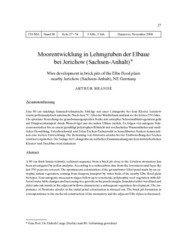Moorentwicklung in Lehmgruben der Elbaue bei Jerichow (Sachsen-Anhalt)
Berichte der Deutschen Gesellschaft für Moor- und Torfkunde
Brande, Arthur
38: 27 - 54
Brande, Arthur, 2008: Moorentwicklung in Lehmgruben der Elbaue bei Jerichow (Sachsen-Anhalt) - Berichte der Deutschen Gesellschaft für Moor- und Torfkunde- Frau Prof. Dr. Elsbeth Lange (Berlin) zum 80. Geburtstag gewidmet -. In: TELMA - Berichte der Deutschen Gesellschaft für Moor- und Torfkunde, Band 38: 27 - 54, DOI: 10.23689/fidgeo-2886.
 |
Dokument öffnen: |
Abstract:
A 80 cm thick limnic-telmatic sediment sequence from a brick pit close to the Jerichow monastery has been investigated by pollen analysis. According to a radiocarbon date from the lowermost mud layer the last 550 years are covered. The spontaneous colonization of the groundwater filled pond starts by an eutrophic natant vegetation, coming from diaspore transport by water birds of the nearby Elbe flood plain biotopes. Four autogenic succession stages follow up to a moderate polytrophic reed vegetation with different water table changes and increasing tree growth on the ponds margin. Inundated alder woodland and alder-ash-oak stands in the adjacent hollows characterize a subsequent vegetation development. The importance of Stratiotes aloides in the initial pond colonization is stressed out. The brick pit formation in correspondence to the medieval construction of the monastery and the adjacent Elbe dykes is discussed. Zusammenfassung:
Eine 80 cm mächtige limnisch-telmatische Abfolge aus einer Lehmgrube bei dem Kloster Jerichow
wurde pollenanalytisch untersucht. Nach dem 14C-Alter der Muddebasis umfasst sie die letzten 550 Jahre. Die spontane Besiedlung der grundwassergespeisten Senke mit eutropher Schwimmblattvegetation geht auf Diasporentransport durch Wasservögel aus der nahen Elbaue zurück. Es folgen vier autogene Sukzessionsstadien bis zu einem gemäßigt polytrophen Röhricht mit wechselnden Wasserständen und randlicher Bewaldung. Erlenbruchwald und Erlen-Eschen-Eichenwald in benachbarten Senken kennzeichnen eine weitere Entwicklung. Die Bedeutung von Stratiotes aloides bei der Erstbesiedlung des Teiches wird hervorgehoben. Die Anlage der Lehmgrube im zeitlichen Zusammenhang mit dem mittelalterlichen Kloster- und Deichbau wird diskutiert.

